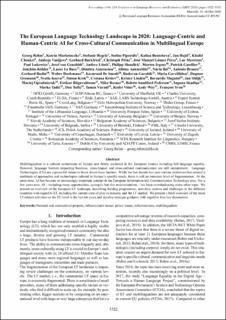The European language technology landscape in 2020: Language-centric and human-centric AI for cross-cultural communication in multilingual Europe
Rehm, Georg; Marheinecke, Katrin; Hegele, Stefanie; Piperidis, Stelios; Bontcheva, Kalina; Hajič, Jan; Choukri, Khalid; Vasiļjevs, Andrejs; Backfried, Gerhard; Prinz, Christoph; Gómez-Pérez, José Manuel; Irgens, Morten; De Smedt, Koenraad; Yvon, François
Chapter
Published version

Åpne
Permanent lenke
https://hdl.handle.net/11250/2739250Utgivelsesdato
2020Metadata
Vis full innførselSamlinger
Originalversjon
In: Calzolari, N. et al. (eds.), Proceedings of the 12th Language Resources and Evaluation Conference, pp. 3322–3332.Sammendrag
Multilingualism is a cultural cornerstone of Europe and firmly anchored in the European treaties including full language equality. However, language barriers impacting business, cross-lingual and cross-cultural communication are still omnipresent. Language Technologies (LTs) are a powerful means to break down these barriers. While the last decade has seen various initiatives that created a multitude of approaches and technologies tailored to Europe’s specific needs, there is still an immense level of fragmentation. At the same time, AI has become an increasingly important concept in the European Information and Communication Technology area. For a few years now, AI – including many opportunities, synergies but also misconceptions – has been overshadowing every other topic. We present an overview of the European LT landscape, describing funding programmes, activities, actions and challenges in the different countries with regard to LT, including the current state of play in industry and the LT market. We present a brief overview of the main LT-related activities on the EU level in the last ten years and develop strategic guidance with regard to four key dimensions.
